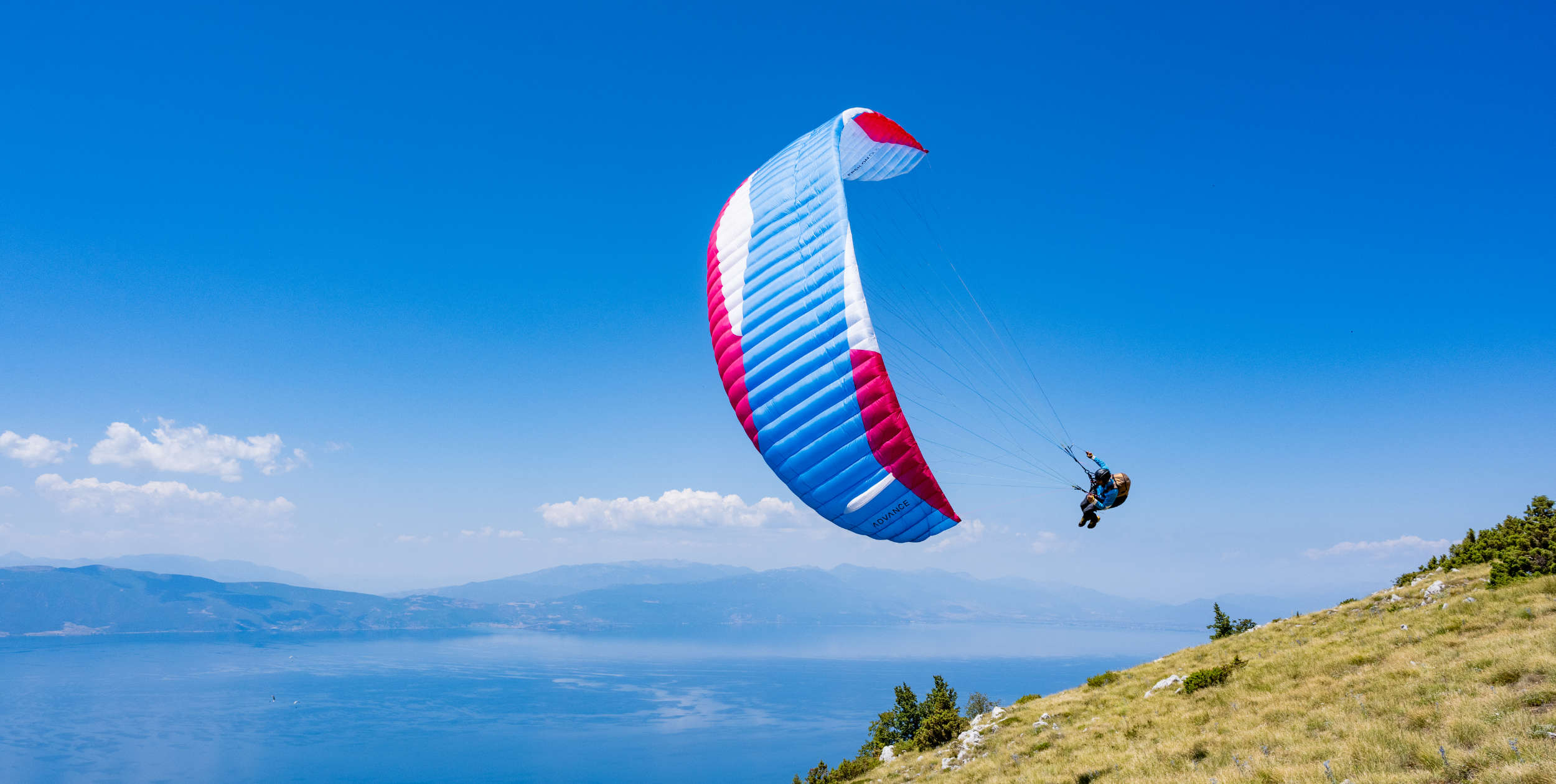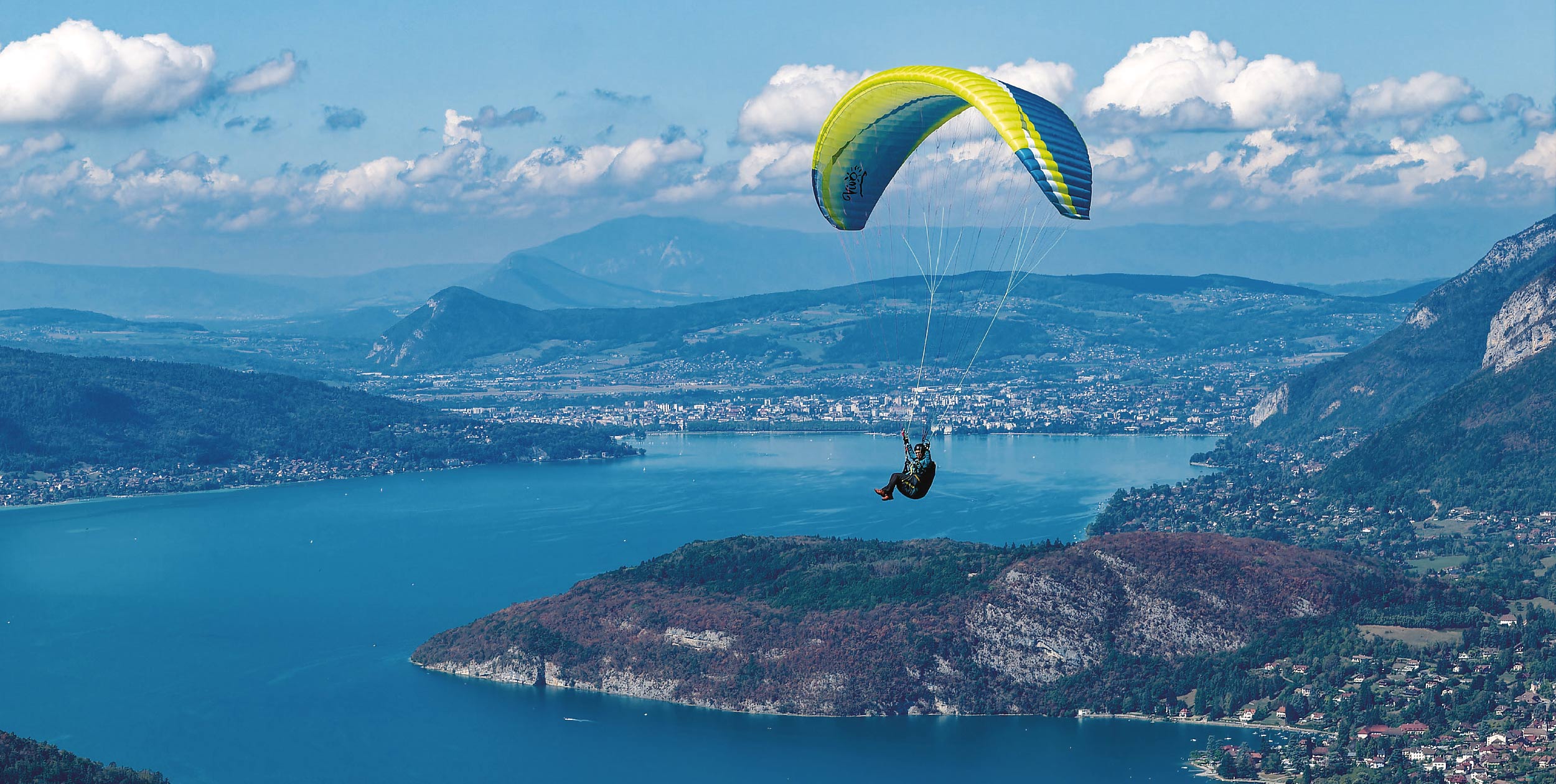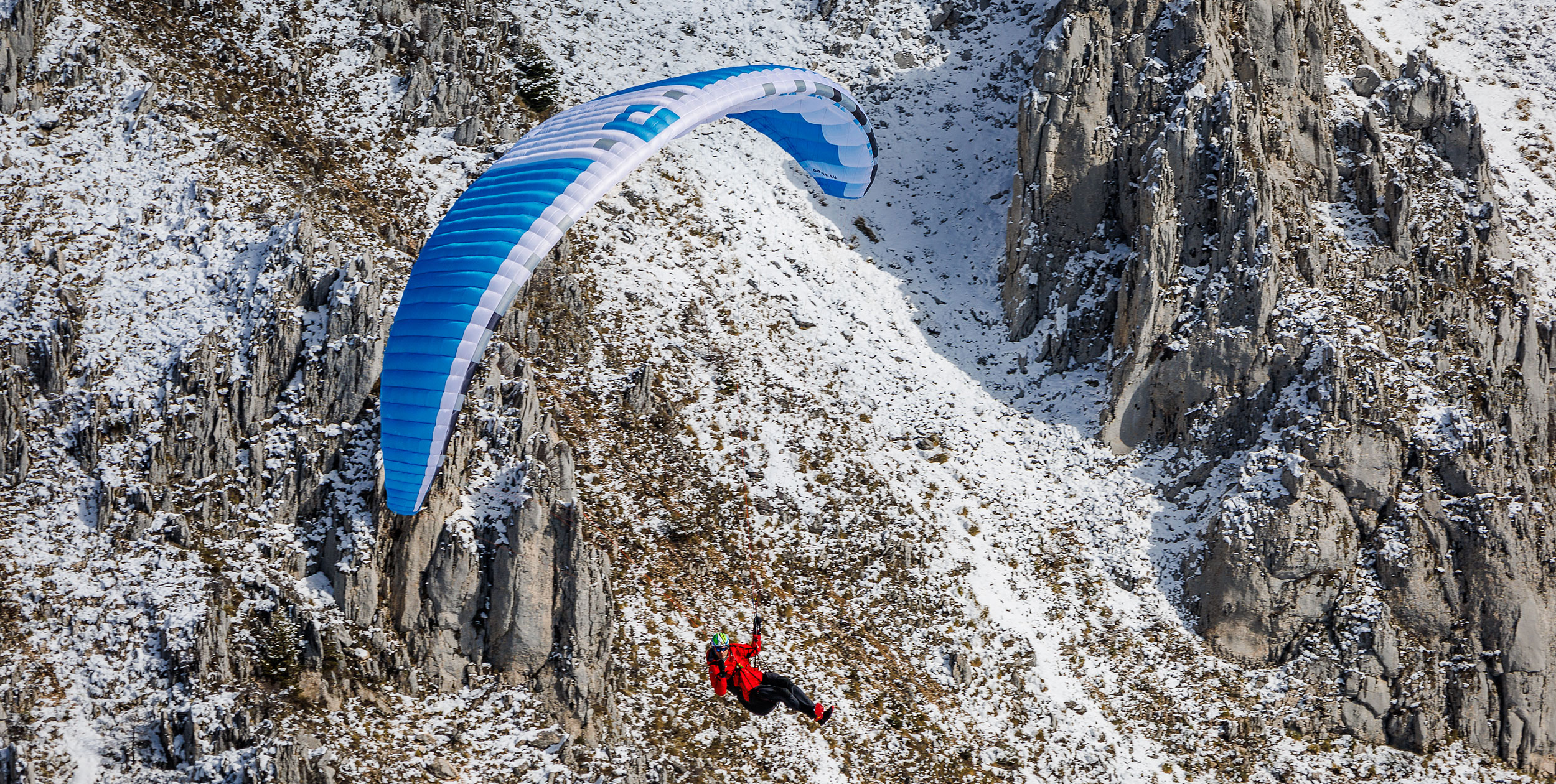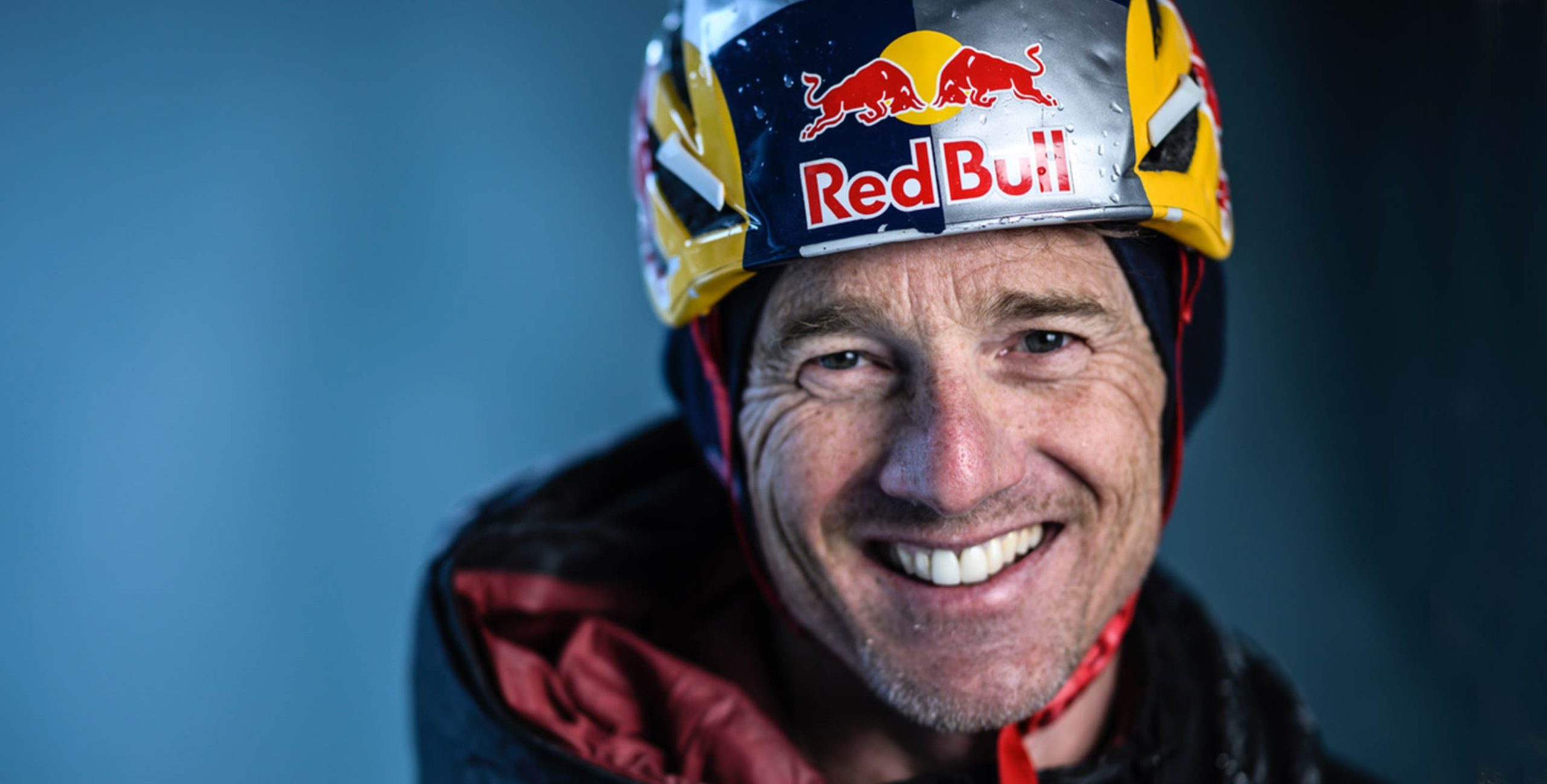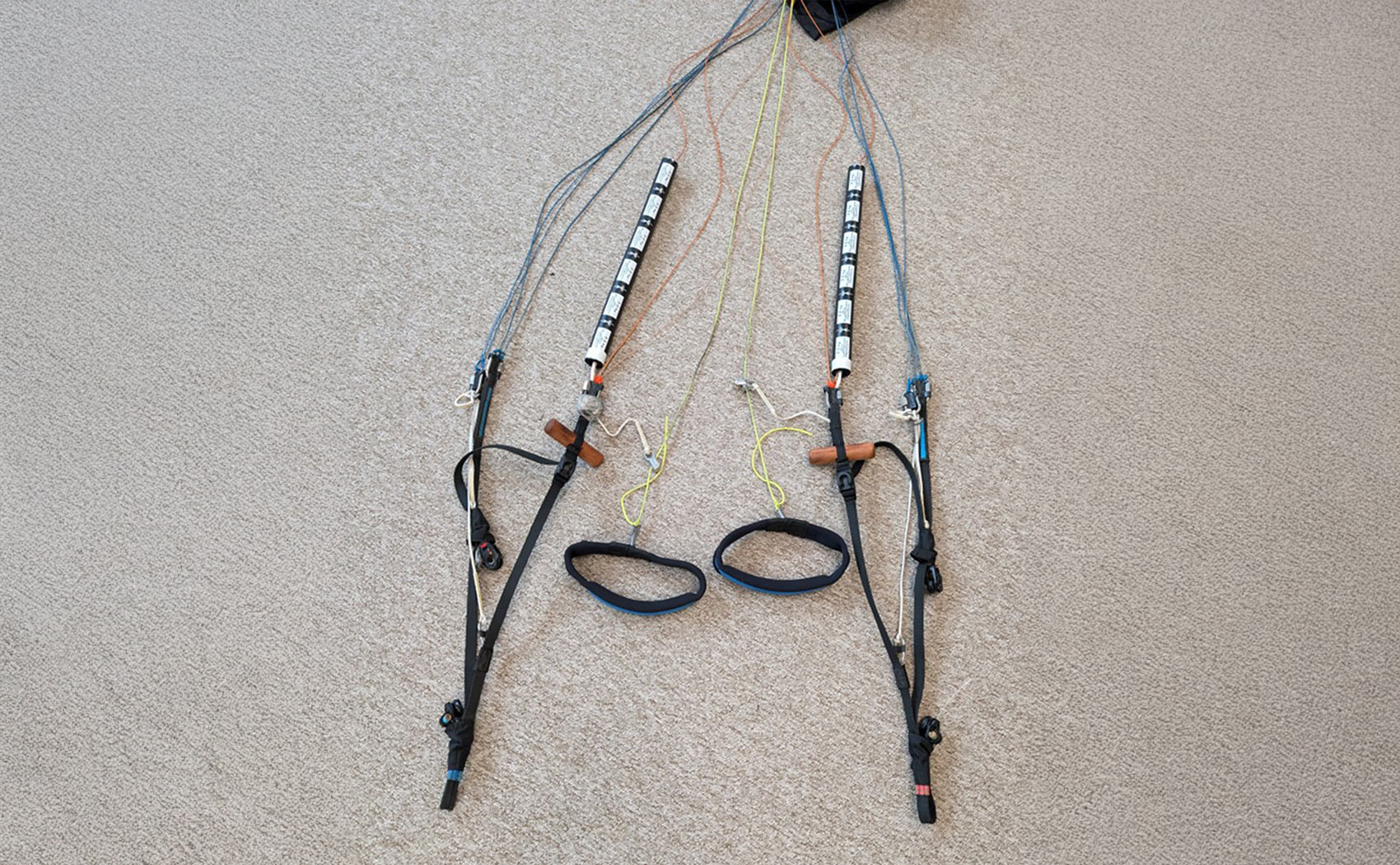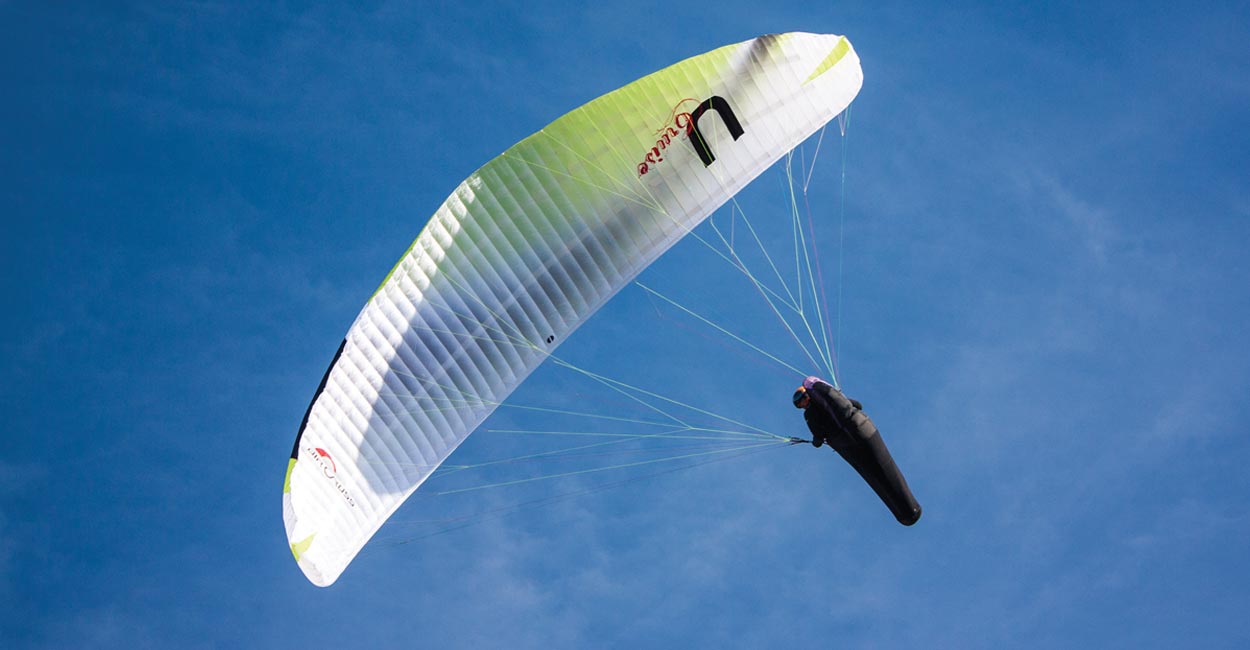
WHEN AIRCROSS’S MANAGER Konrad Görg asked us if we would review their latest wing I jumped at the chance. A few days later when I got an email to say that Konrad had just flown a whopping 446km on the wing in Brazil my interest levels rocketed.
The wing, AirCross say, has been designed to sit at the top of the EN-B category. The company have squeezed as much speed and performance into the wing as they can, while still retaining EN-B certification. This means the glider is not suitable for – or aimed at – all ‘EN-B’ pilots. It is not a wing to ‘step up to’ after your first glider. It is a serious XC machine that demands the skill and attention of an experienced cross-country pilot.
That said, Konrad’s 446km flight was the longest flight ever on an EN-B and went quite some way to prove the performance of the wing, albeit in the hands of a capable pilot in a great location. A few days after that big flight the postman rang, announcing the wing had arrived.
First impressions
I was immediately struck by its weight. The large size I flew weighs 6.2kg which, though not excessive, seemed high coming off my Nova Mentor 4 Light (4kg).
The wing is made from a mix of Skytex and Dominico cloth, not the featherweight materials found on some wings. There is also a relatively high cell count of 65: which is just 13 less than an Ozone Zeno (EN D). It’s a sign that AirCross have chosen to prioritise performance over production costs and weight.
Aspect ratio hasn’t been pushed so far, with a relatively low 5.6. Compare that to the likes of the Gin Carrera+ at 6.2 and the UP Summit XC4 at 6.3, both EN-B wings. Like Nova’s Phantom, AirCross have chosen to mix lower aspect ratio with more cells to achieve a mix of performance and easier handling. The Phantom however has 99 cells. AirCross have also kept to a more traditional, but still complex, internal structure and have used full-fat materials for longevity.
It is obvious that a lot of work has gone into making the wing as clean and crisp as possible; a few of my fellow pilots commented on how clean it looked.
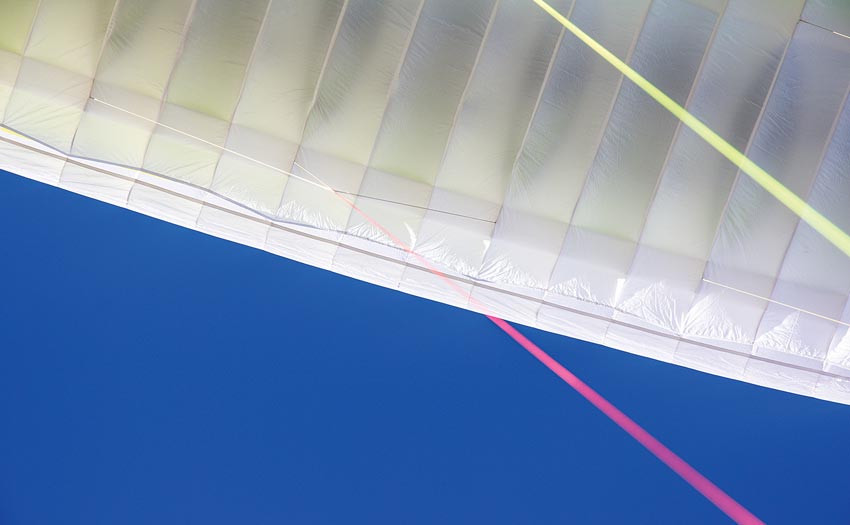
Design elements
The wing has a pronounced sharknose. The cell openings are also pretty small for an EN B. Each group of three cells has a semi-circular opening with the central cell fully open and the ones either side semi-closed. This gives the nose a racy look more fitting of a comp wing.
There is quite a bit of plastic supporting the leading edge, and the stabilo has a rod running the full length of the wingtip. Designer Paul Amiell said this, “Helps create a very clean tip, which is good for performance. Plus I think it looks good.”
At the rear there are the now common mini ribs, there to improve the profile shaping.
The wing uses three risers, but the upper C-lines split to D-tabs in the centre section of the wing, so it is not a true three-liner. The upper lines are unsheathed, but the main lines have colour-coded coverings for easy sorting on launch.
The risers themselves are made from thin webbing and are nicely constructed without any superfluous gimmicks.
I asked about the lack of C-handles, or indeed any mention of rear-riser control in the manual, and Konrad told me, “Small pulls backwards on the Cs work quite well for changing heading or to stabilise the wing on glide, but to be honest I don’t use this technique.”
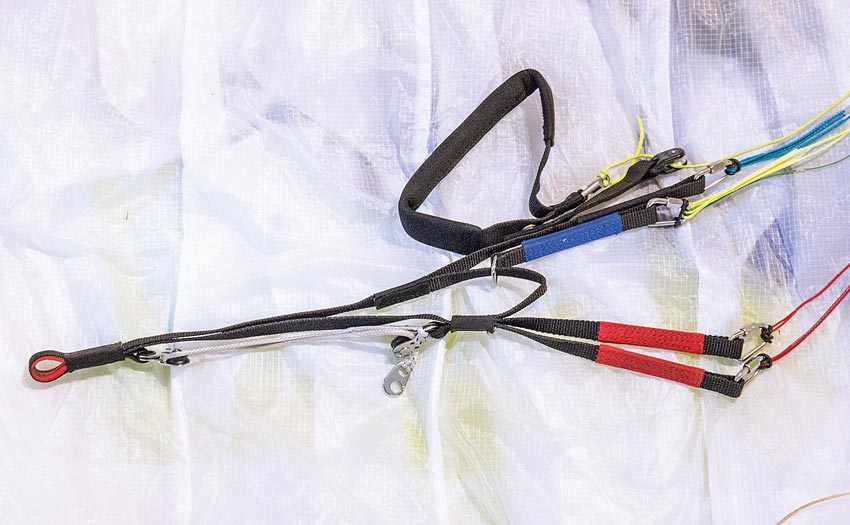
On launch
Once unrolled the wing builds a wall nicely in any reasonable wind, the coloured lines making it easy to sort them before take-off. Magnet-haters will be happy to hear that AirCross have made use of good old poppers: guaranteed to stay in place as you get things sorted.
On the pull-up the wing feels quite heavy and needs pressure all the way. Having said this, it rises smoothly with no sticking point and was easy to keep coming up straight. Once above your head there was no tendency to overshoot and it was easy to keep above me.
Overall the wing proved to be easy to handle on the ground but wasn’t exactly leaping into the air. With this, dare I say, slightly agricultural feel (when Konrad Görg isn’t selling or flying paragliders he is running his family farm) on launch, I was worried how this would translate into handling in the air.
First thermal
With my first turn in the first thermal those worries disappeared. The brakes – which feel solid but not overly heavy – react quickly and precisely as you start the turn. Although the glider is tolerant of deep brake inputs, with pressure ramping up to let you know you are near the stall point, the control you need for thermalling is over a short part at the beginning of the travel. This gives you precise control of the wing.
The U Cruise has no sticking points when turning, and it is easy to maintain a turn once in. Adding a bit of weightshift will bank it up more but the wing is pretty stable in roll, so I didn’t have to put much effort into managing this. The glider holds energy well so using bit of outside brake for control won’t bleed it all away.
The ride is reassuringly solid: the wing is obviously well pressurised and acts as a solid whole. The comfort level is good, definitely more than my lightweight Mentor 4. The wing stays planted above your head with very little movement. This could feel disconcerting at first coming from a livelier machine, but I soon got used to it. I found myself very much enjoying the smooth and efficient ride.

Feedback
While a solid glider is all very well for comfort, sometimes it can mean you struggle to feel what the air is doing. As I had the U Cruise over the middle of winter the cold stable days meant the thermals in the south of France weren’t their normal sporty strengths. Instead, they were often tricky weak affairs that were broken up by inversions.
In these I found the wing gave good feedback through the brakes about what the air was doing. Something I came to love was that it feels like you are extending your fingers out into the airmass, feeling it out. Good for sniffing out the stronger bits of lift.
Entering thermals there isn’t much pitch movement at all. The wing cuts in nicely but doesn’t particularly accelerate into the cores. It’s the same when flying through turbulence – the U Cruise just seems to cut through it all, largely unaffected. This isn’t to say you shouldn’t be flying actively, but I found myself only using small brake movements to keep the wing where I wanted.
All this makes for a wing that is undemanding to fly. Flying near the middle of the weight range I found the good sink rate and the ability to make good use of the lift flattered my flying.
It’s quick
Even in mid-winter where I live in the south of France you can go XC. Where the higher hills meet the coastal plains of the French Riviera there are still plenty of possibilities. The south-facing ridges give options for out-and-returns and flat triangles even when climbs are weak and your altitude is capped. With very few landing options thanks to the forests and the urbanisation though, you need efficient glides and good climbing performance to keep stress levels down.
Trim speed is already on the high side. The TAS on my Flymaster gave a consistent reading of 37/38 km/h – a few km/h faster than many wings. On my first crossing I found the bar pressure nice and light making it easy to use. The first step gives a good increase in speed with no noticeable increase in the sink rate. Pushing pulley-to-pulley I was surprised to find the TAS gave me a steady reading of 50km/h peaking at 51. That’s slightly faster than we got from Swing’s Nexus, a wing we found to be one of the faster ones in the EN-C range. More impressive is this speed was attained flying the wing right in the middle of the weight range.
When flying pulley-to-pulley the wing still feels taut and reassuringly solid. There is none of the bowing between the ribs on the leading edge that is a sign of a weak nose. It didn’t move about much at all, even when flying through reasonable turbulence. It was easy enough to control what little pitching there was with small bar movements. The wing reacted well to inputs on the rear risers but didn’t give that much information.
As I headed along the ridges I found myself in the company of Zenos, EN-Ds and high-end EN-Cs. The U Cruise performed well and the glide seems efficient for the class. When heading back I had to push round corners into wind and the wing coped well, giving a smooth reassuring ride.

Security
I didn’t have a single collapse, despite diving in low to thermal out of rocky ridges where the cores were tight and spicy or on days when the wind was blowing them apart. At all times the wing felt solid and pressurised.
Pulling on the As to induce a collapse takes quite a bit of force, partly because the tabs are set back but also a sign of the pressure in the wing. This has the effect of accelerating the wing as you try to pull a collapse – but the couple I tried showed no abnormal behaviour and were in line with the certification.
Big ears work well as a descent technique, especially when used with the bar to take you away from the danger. Once released the high pressure in the wing means they quickly reinflate on their own.
The wing holds a good amount of energy and it doesn’t take that much for wingovers to build quite quickly. Again, a little care needs to be taken when exiting spirals to bleed off the energy smoothly. However the behaviour is not unusual for this class of wing.
Conclusion
With a secure feel and great performance the U Cruise is undoubtedly a kilometre-muncher; was that ever in doubt after Konrad’s amazing flight? With its racy feel both on and off the bar and solid structure in the strong stuff it should be effective on strong Alpine days: big climbs and long glides.
The solidness of the wing may lure inexperienced EN-B level pilots to fly it, as unlike some of the high-aspect ratio wings at the top of the category the U Cruise feels easy to fly. However, bear in mind that this wing is fast and quite heavy and it holds a lot of energy. A blowout at full speed on such a glider is a different thing to a blowout on a slower, lightweight mid-B. At the end of the day, the manufacturer recommends it for pilots looking for a wing at the top end of its class, where its performance certainly puts it. Wise pilots will heed that advice.
Construction is full fat. It means you get a heavier wing that is harder to walk with, but that will last you over a number of years or cope with harsher launch conditions. Pilots that live in areas with rocky, dusty launches will appreciate its robust build. Besides, the performance of this wing hopefully means you won’t be walking all that far at the end of your flights anyway.
****
Q&A: DESIGNER PAUL AMIELL
Tell us a bit about yourself
Born in 1940 I’m a self-taught engineer who has a passion for anything that flies without an engine. Back in 1978 I was a keen skydiver. I was one of the original small group that took parachutes to Mieussy, between Chamonix and Geneva, to try and fly them. It was the birth of paragliding.
How did you become a designer?
I was already an engineer and loved to design my own toys. When we started flying at Mieussy it was evident that it would be easy to make something better than our parachutes for free flying. So I set about designing a wing for myself and then for ITV. I worked for ITV from 1985 to 1992, then E2RA and more recently MCC Aviation and AirCross. I’ve also designed, cut and sewn a few wings at home for my own pleasure that I have taken flying.
You have a long pedigree, what’s your most memorable wing?
Maybe the Asterion. I designed it for ITV who were considered one of the first real paraglider companies. From 1985 to 1992 we won many championships both national and international with wings that I designed alongside Michel LeBlanc. I am particularly proud of the Meteor Gold, the last wing I desgned for ITV. Now of course I am proud being the designer of the first EN-B glider to pass the 440km mark.
What was the brief when you started the U Cruise project?
Konrad wanted a high-level EN-B paraglider optimised for XC but with the behaviour of a real B and the best performance we could obtain using cutting edge technology.
What were the challenges in the design?
The biggest difficulty was to get a glider with all the manoeuvres fitting in the EN-B category. We had a lot of prototypes flying well but the problem was making sure we got the right behaviour in accelerated collapses without compromising the top speed of the wing. At the same time Konrad was changing his requirements during development as he wanted it to be state of the art. We ended up changing the profile and the leading edge during this period, so it took nearly three years to reach the final product.
The wing bucks the lightweight trend. Why?
One of the main reasons for the weight is the high number of cells. We wanted to get a better, cleaner shape and decided not to worry so much about the production costs and the weight. It’s a wing designed to fly cross-country from normal sites, so we decided performance was more important than weight. Also, as we feel the wing is technically advanced, we hope pilots will be able to keep it for several years.
Do you have advice for pilots moving to the U Cruise?
Yep, let it fly. It has a high trim speed with a good glide that will take you further. You need to take a bit of time to get used to this glider, especially as it is very stable in pitch.
What next?
We are working on a couple of two-line gliders. Our prototype CCC wing is looking very promising, but we are also working on the possibility of building this concept into an EN-D wing with an aspect ratio of just under 7.
****
Manufacturer’s Specifications
What AirCross say: “From hobby to competition pilot – this glider will bring pure joy, especially to those who fancy long distance flights”
Use: XC
Pilot level: Intermediate and those looking for performance with security
Sizes: S, M, L, XL
Flat area (m²): 23.50, 26.67, 28, 30.50
Take-off weight (kg): 60-85, 75-100, 90-115, 105-130
Glider weight (kg): 5.4 – 6.6
Cells: 65
Flat aspect ratio: 5.6
Certification: EN / LTF B
Marcus flew the Large U Cruise (90-115kg all up) at an all up weight of 103kg with an Advance in Impress 3 in the South of France.
To stay up to date and read our reviews first, subscribe to Cross Country


